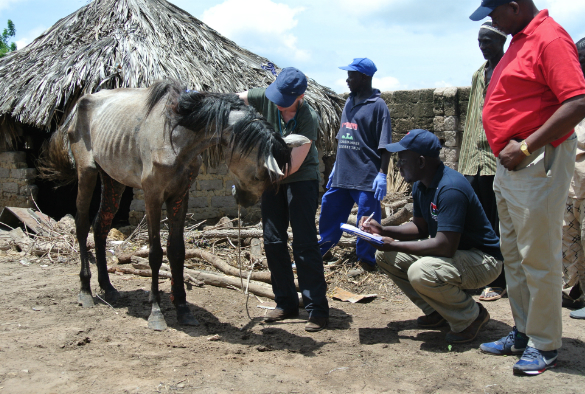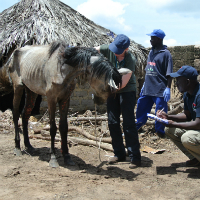
Dr Claire Scantlebury is a Research Fellow in Functional and Comparative Genomics at the Institute of Integrative Biology.
What if I told you that horses and donkeys are critical to people’s lives? It may not seem obvious, but working alongside the Gambia Horse and Donkey Trust (GHDT) left me in no doubt. A sick horse or donkey cannot work for their owners, and the loss of equid draught power, the sustainable equivalent of the tractor, means that daily tasks for families producing their own food become more labour-intensive and time-consuming.
I spent two weeks working with the GHDT mobile veterinary team and regional livestock agents, visiting different regions of The Gambia, to investigate an infectious disease that has been circulating among the horses and donkeys. I am a veterinary clinical researcher specialising in histoplasmosis and the purpose of my visit was to use diagnostic methods to identify if it is contributing to an outbreak of disease in equids. Histoplasmosis is an infectious and chronic disease which causes epizootic lymphangitis (EZL). In its advanced stages it leads to lameness and debilitation and, if left untreated, sometimes death.
The fieldwork involved long journeys with a dedicated team of four GHDT vets and animal health professionals. The task was to collect samples of pus and blood from suspected cases to prepare for analysis in Liverpool.
A new trunk road on the south bank of The Gambia River allows for relatively easy travel. The road running parallel on the north bank provides connectivity to previously remote villages. From these main arteries, farming communities can be accessed by dust tracks, where the morning and evening rush hours sees horse and donkey carts carrying people, ploughs and equipment back from the fields. The animals are also used to plough the fields during the day.
It was clear that horses and donkeys are still intrinsic to people’s lives and greatly benefit families. People attending the GHDT clinics were eager to have their animals treated and so calmly and expertly handled them to allow this.
Not all cases demonstrated a similar level of care. One donkey arrived with wounds on its withers and rump. The owner explained that the animal had got loose and trampled and eaten through another family’s crop field. The owner of the field then chased the donkey with a machete. The clinical team cleaned and dressed the wounds and provided antibiotics to treat infection. I wondered how the violent action was justified. Saloum, a long-serving member of the GHDT gave an explanation: it takes weeks or months of long, back-breaking hours in the sun to grow crops for the family to survive. This incident, with the donkey demolishing those efforts irreversibly in terms of time and resources, may explain the man’s actions. I’m still not sure that I completely understand the reaction, but given the context, it isn’t that straightforward.
As well as collecting samples, our team treated cases using imported potassium iodide and iodine. Sourcing antifungals, and many other medicines, is difficult in The Gambia. This has a significant impact on animal and human health. While there, I was asked to provide first aid to three people who were unable to access a doctor and lacked even basic medical supplies e.g. antiseptics, dressings, painkillers and antibiotics. Access to healthcare is a critical area that international policies such as Sustainable Development Goals aim to address. The people and animals I saw are prime examples of the crucial work required.
The samples collected during this field work were first processed in The Gambia. The blood was analysed and pus smears were examined using light microscopy and inactivated before being preserved onto Whatman filter paper cards to allow safe transportation back to Liverpool. The findings from the project will inform equine disease surveillance in The Gambia.
The Gambia Horse and Donkey Trust treat animals and provide training to develop animal health capacity in the country. You can follow them at: https://www.facebook.com/gambiahorseanddonkey.
I am grateful to the GHDT team, in particular Heather Armstrong, Dr. Demba Jallow, Dr. Abdou Ceesay, Saloum and Mambala Jallow and staff at the Department of Livestock Services for allowing me to work with them.
